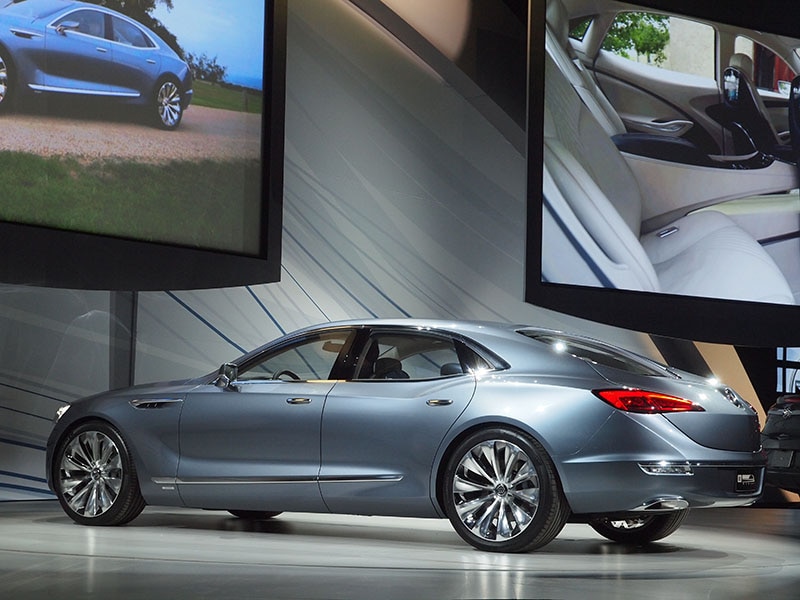Recent Articles
Popular Makes
Body Types
Five For Friday: Five Thoughts About The Auto Industry For January 16, 2015

It’s Friday once again, which means it’s time for another round of my Five For Friday: Five Thoughts about the Auto Industry for January 16, 2015. Focusing on this week's North American International Auto Show in Detroit, Michigan, there's a lot to talk about: the Chevrolet Bolt vs. Tesla's vaporware, the Buick Avenir concept's gorgeous sheet metal, Ford's EcoBoost agenda, the Hyundai Santa Cruz 'Concept,' and the auto-only 2016 Cadillac CTS-V. Let’s look at my take on the most noteworthy and interesting automotive stories from the past week.
1. Chevrolet Bolt Is Not A Tesla Competitor
The Chevrolet Bolt's debut at the Detroit auto show brought a hailstorm of comparisons between the compact electric vehicle, with its proposed 200 mile battery range, and the Tesla Model 3, a proposed entry-level offering from the nascent automaker. Let me be clear: the Bolt is not a Tesla competitor. Why not? It's simple, really: in order for the Bolt to go up against the Model 3, the latter would have to actually exist. Until the Model 3 leaves the drawing board and enters production, or even appears as a concept somewhere, it's far more instructive to contrast the Chevrolet EV against rivals like the Nissan LEAF.
Keep in mind that Tesla hasn’t yet been able to build the Model X SUV, which is essentially a re-bodied Model S, with the most recent announcement for the vehicle delaying it until early 2016. Running a car company is difficult, and to succeed Tesla needs to be more than a single-product brand.

2. Buick Avenir Concept Is Beautiful, Won't See Production
The most gorgeous car I saw in Detroit this past week actually appeared the night before the show opened at a special off-site event that was ostensibly held to introduce the Buick Cascada convertible. In addition to the new drop-top, however, we were shown the real star of the show, which was the surprise Buick Avenir concept. This full-size sedan is the most beautiful car I've seen from General Motors since the El Miraj, and certainly represents a big step forward for Buick in moving away from the Opel-influenced designs that play a big role in its current line-up.
Unfortunately, my sources at Buick tell me that the Avenir will not be built. In fact, the closest we'll get to an Avenir-like model will be the next-generation LaCrosse full-size sedan, which will crib some, but not all, of the Avenir's design elements. This is a real shame, for while I can understand Buick not wanting to upstage corporate sibling Cadillac in the luxury game, the chance to enjoy a more distinctive styling stamp via an in-house grand slam like the Avenir doesn't come along every day.

3. Ford EcoBoosts Everything
Both the Ford GT (another surprise, although more thinly veiled) and the Ford F-150 Raptor saw their upcoming models previewed in Detroit, and while each vehicle offered a number of intriguing design points (the Raptor's 10-speed autobox, the GT's ultra-exotic body work), what struck me was Ford's move away from eight-cylinder engines in favor of simply EcoBoosting everything.
Both the GT and the Raptor feature the same engine, the brand's familiar 3.5-liter, twin-turbo EcoBoost V-6, which in the GT has been tuned to produce over 600 horsepower. In the Raptor, the numbers were more vague, but the promise was made that the EcoBoost mill would out-perform the 5.0-liter V-8 that it replaces under the current truck's hood. How much longer before we see the 3.5-liter unit on the Mustang GT's options sheet? How many more years before the EcoBoost V-6 becomes as ubiquitous as Nissan's VQ series once was?

4. Hyundai Santa Cruz Concept Is A Thinly Veiled Production Pickup
The Hyundai Santa Cruz Concept is a production pickup in all but name. That's what I was told by Mark Dipko, Director of Corporate Planning at Hyundai, who explained to me that every component of the Santa Cruz was based on an existing platform and that there were no barriers to bringing the truck to market. Well, maybe not every piece of the truck: the vehicle's trick extendable tailgate is all-new, and is still undergoing patent certification so I wasn't able to get a close look. I liked everything else about the Hyundai pickup, however, which featured a 2.0-liter turbodiesel four-cylinder engine, 300 lb-ft of torque, and an urban-friendly form factor. I hope they build it, because if they do it'll be the only true compact truck currently on the market.

5. 2016 Cadillac CTS-V Is Auto-Only
The 2016 Cadillac CTS-V made a splash in Detroit with its 640 horsepower, 6.2-liter supercharged V-8 engine and its 200-mph top speed. In some ways, though, the third-generation CTS-V marks the end of an era, because this model will only come with an eight-speed automatic transmission. The lure of a high-horsepower four-door car with a manual gearbox was what made me purchase a CTS-V when the model first came out (I own a 2004), and to see the Cadillac 'graduate' to the executive car realm where shifting yourself is an unwelcome nuisance rather than a prime attractor is disappointing - even if I do understand the business case behind the decision. With the equally-new ATS-V filling the role of traditional track star with its manual option, the CTS-V is free to explore new market heights and find a fresh cohort of well-heeled customers. But that doesn't mean I have to like it.
